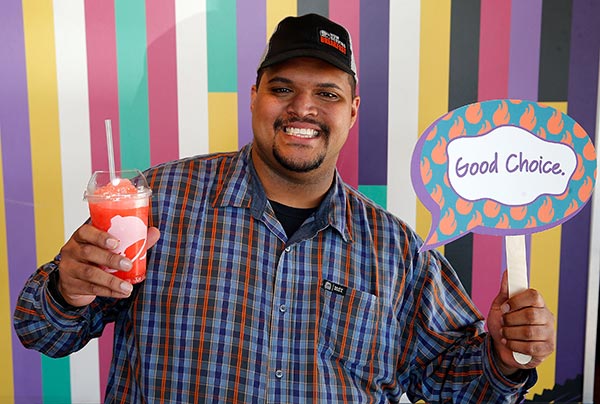So you’ve heard of job fairs, recruiting events, and career fairs. Now, it’s time to talk about hiring parties. Over the past few years, companies have started throwing these parties to put a new spin on the traditional hiring experience, meet staffing needs, and foster their company culture.
But what exactly is a hiring party, and how can you host one? In this article, you’ll read all about these events, why they’re important, and how you can host your own! And as an added bonus, we’ve also prepared a short case study to highlight Taco Bell’s success with hiring parties so you can gather some inspiration.
What is a hiring party?
A hiring party is a unique twist on the traditional job fair. Instead of meeting with recruiters in a formal setting and inquiring about open positions, job seekers can gather on-site, casually mingle with staff, and learn more about the organization and its culture.
This creative approach to the hiring process attracts new recruits by introducing them to their potential workplace and giving them a taste of the actual employee experience. That way, candidates have a better idea of what they’re signing up for, and managers can see job seekers in action, better assess their suitability for open positions, and even offer on-the-spot job interviews.
How to host a hiring party in 4 easy steps
Like any large event, a lot of work goes into planning a hiring party. You have to design the invitations, figure out the date and location, and get the word out, just to name a few tasks. But a hiring party is a great way for small to medium-sized businesses (SMBs) to build brand visibility, speed up the hiring process, and advertise their unique culture. That’s why we’ve put together a list of four steps you can take to host your first hiring party with ease.
Step 1: Figure out the what, when, and where
First, choose your party’s date, time, and place. If possible, host the event at the same location where successful candidates would end up working. This gives them a better idea of their potential future workplace. Just make sure you’ve got enough empty space to accommodate the anticipated number of candidates.
Then, try to provide a couple of event dates to offer candidates more flexibility and attract more people. If you’re able to host your party in your workplace, be sure to pick a time and date that’s normally less busy so everyone can focus on the event. Alternatively, you can plan your event on the weekend or before or after working hours.
You should also ensure you’ve got a clear space where you can set up an application station. Consider having a few tablets out where candidates can enter their personal and professional details so they don’t have to bring an application or apply online beforehand. That’s what the party is for!
Step 2: Make it a party
This is your chance to make your hiring process stand out from all those that job seekers have experienced before. Create your own games, like on-brand trivia, and consider setting up decorations, balloons, freebies, or Instagram-worthy photo booths or backdrops. This helps candidates stay engaged and relaxed, especially if they’re waiting to be interviewed. And don’t forget to put on some nice tunes in the background! Spotify’s Hot Hits playlist has popular tracks that most people will like.
“Don’t make the environment too formal or similar to a job fair. Offer prizes, gift cards, or free food as signing bonuses to attract more candidates.” — Brian David Crane, Founder of Spread Great Ideas
For example, in 2018, Taco Bell threw their first of many hiring parties with free nacho fries and watermelon freezes, party games like Taco Bell trivia, and even signing bonuses in the form of gift cards for those who got hired on the spot.
Finally, avoid serving alcohol at your hiring party. This will help job seekers keep a clear head and save you the trouble of hiring bartenders, making sure you’re compliant with state laws, verifying you’re licensed to serve, and taking steps to prevent drunk driving.
Step 3: Advertise the occasion
Next, it’s time to get the word out about your event. The good news is that if you generate enough buzz about your hiring party, you might see a nice bump in online applications from those who are interested in a job but can’t attend your event.
You can use lots of different channels and methods to market your party, depending on your business size, location, and intended audience. For example, if you’re targeting young millennials and Gen Z workers, consider promoting your event on social media platforms like Instagram and TikTok instead of Facebook or email. Because with only around 32% of Gen Z using Facebook in 2022, they’re unlikely to come across your advertisements at all.
If possible, consider dedicating a small budget to running some paid ads on your social media channels. That way, you can target your message to those in specific industries, age groups, or geographic locations.
You can also create an event on your business’s Facebook or LinkedIn page. Then, boost it to reach a wider audience or manually send out invites to your followers and target candidates directly on-platform.
Finally, don’t forget about print advertising! Create a simple but on-brand flier that outlines details like the time, date, and location of your event and briefly explains what candidates should expect. For example, what’s your party’s dress code? Should candidates bring their resumes along with them? What time does the event start and end?
You can then put up your flier at local stores, coffee shops, schools, or wherever you think your target candidates might hang out.
4. Follow up with candidates
Finally, make sure to follow up with the candidates who attended your hiring party and showed interest in working for your business. That’ll help you make a positive impression on job seekers and build your talent pipeline — a database of talented candidates you’re likely to hire in the future — at the same time.
As much as possible, make sure to thank all participants for showing up, whether you think they’re promising applicants or not. Then, review all the resumes you received, decide which candidates fit your requirements, and reach out to them as soon as possible. You can also connect with your strongest applicants on LinkedIn!
If you offered someone a job on the spot, reach out to them as soon as possible after the event to begin their onboarding, training, and background check processes.
A case study on Taco Bell’s successful hiring parties
In 2018, Taco Bell announced it would begin throwing hiring parties as a new recruitment strategy to meet their goal of hiring 100,000 employees by 2022. And in April 2019 alone, the franchise hosted 600 hiring parties at Taco Bell restaurants in 450 cities across the country, which were an integral part of beefing up their seasonal staff team for a busy summer season.
The parties were open to anyone curious about working at Taco Bell and provided job candidates with a chance to mingle with the restaurant staff, learn more about the perks (for example, scholarship opportunities and educational counseling), and possibly even get hired on the spot.
“At Taco Bell, we believe that creating a different sort of workplace starts with a hiring process that’s as unique as we are,” Chief People Officer Frank Tucker said in a statement. “People are an integral part of our brand, and hiring parties provide job candidates with an insider’s look at what makes Taco Bell restaurants a place they should want to work and grow.”
“It’s important to ensure passionate employees can get the most out of their time working at a Taco Bell restaurant — beginning on day one,” Vice President of People and Experience Bjorn Erland said. “Whether you start in a Taco Bell restaurant as a seasonal team member or stay for a decades-long career, everyone should be able to pursue their personal, professional, and educational passions.”
Meet staffing demands and foster workplace culture with hiring parties
Hiring parties are a good way to stand out from the crowd in a challenging labor market. They give you a chance to get creative, increase brand awareness, expedite hiring, and bring visibility to your company culture. That’s why in this article, we went over four possible steps you can take to throw a great hiring party, along with providing a case study on Taco Bell’s successful hiring parties to get you inspired and show you what they might look like.
And when you’ve finished your hiring party and have new applicants to hire, onboard, and train, Homebase’s hiring and onboarding software can help you set them up for success.
Hiring party FAQs

What is the difference between a hiring party and a job fair?
A hiring party is an informal gathering hosted by a business in order to attract new hires and give them a chance to mingle with existing staff, as well as learn more about the company culture and perks.
A job fair, on the other hand, is an event where job seekers can look for various employment opportunities in a more organized and formal setting. They’d likely speak to different employers, recruiters, and HR professionals about the businesses that are hiring, the qualifications interested applicants need, specific job openings, and the application process.
Where should I hold my hiring party?
If possible, it’s best to host your hiring party wherever your employees actually work. For instance, a restaurant could throw a hiring party in their restaurant space before they normally open or outside of working hours. This way, job seekers get a better sense of the job, the working environment, and the team’s dynamics.
What are some common mistakes to avoid when hosting a hiring event?
Some of the most common mistakes to avoid when hosting a hiring event include:
- Not promoting the event thoroughly or only advertising it on one platform
- Not allocating enough time for planning and preparations
- Overselling or misrepresenting company culture
- Failing to have a plan B
- Not following up with interested people or candidates after the event

